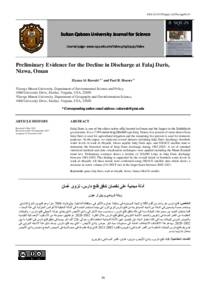Document
Preliminary evidence for the decline in discharge at Falaj Daris, Nizwa, Oman.
Identifier
DOI:10.53539/squjs.vol29iss1pp56-67
Source
Sultan Qaboos University Journal for Scientific. v. 28, no.1, p. 56-67.
Contributors
Houser, Paul R., Author
Other titles
أدلة مبدئية على نقصان تدفق فلج دارس، نزوى، عُمان.
Country
Oman.
City
Muscat.
Publisher
College of Science, Sultan Qaboos University.
Gregorian
2024-04-24
Language
English
English abstract
Falaj Daris is one of the oldest active aflāj located in Oman and the largest in the Dakhiliyah governorate. It is a 7,999-meter long Dāwūdī-type falaj. Ninety-five percent of water drawn from falaj Daris is used for agricultural irrigation and the remaining five percent is used for domestic purposes. In this paper, we analyzed several datasets including falaj Daris discharge, borehole water levels in wadi al-Abyadh, whose aquifer falaj Daris taps, and GRACE satellite data to determine the historical trend of falaj Daris discharge during 1982-2020. A set of standard statistical methods and data visualization techniques were applied including the Mann-Kendall trend test. Preliminary evidence shows a decline of 226,000 L/day in falaj Daris discharge between 1982-2020. This finding is supported by the overall trends in borehole water levels in wadi al-Abyadh. All these trends were confirmed using GRACE satellite data which shows a decrease in water volume of 6 (WET cm) in the larger basin between 2002-2021.
ISSN
2414-536X
Arabic abstract
فلج دارس هو أحد أقدم الأفلاج النشطة الموجودة في سلطنة عمان والأكبر في محافظة الداخلية. وهو فلج من النوع الداوودي يبلغ طوله 7999 مترًا. ويستخدم خمسة وتسعون في المائة من المياه المستخرجة من فلج دارس لأغراض الري الزراعي، بينما تستخدم الخمسة في المائة المتبقية للأغراض المنزلية. في هذا البحث، قمنا بتحليل العديد من مجموعات البيانات بما في ذلك تصريف فلج دارس، ومستويات مياه الآبار في وادي الأبيض، الذي يستغل طبقة المياه الجوفية فلج دارس، وبيانات الأقمار الصناعية GRACE لتحديد الاتجاه التاريخي لتصريف فلج دارس خلال الفترة 1982-2020. تم تطبيق مجموعة من الأساليب الإحصائية القياسية وتقنيات تصور البيانات بما في ذلك اختبار اتجاه مان كيندال. وتشير الأدلة الأولية إلى انخفاض مقداره 226 ألف لتر/يوم في تصريف فلج دارس خلال الفترة 1982-2020. ويدعم هذه النتيجة الاتجاهات العامة في مستويات مياه الآبار في وادي الأبيض. تم تأكيد كل هذه الاتجاهات باستخدام بيانات القمر الصناعي GRACE والتي تظهر انخفاضًا في حجم المياه بمقدار 6 (WET cm) في الحوض الأكبر بين عامي 2002-2021.
Category
Journal articles

